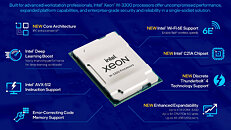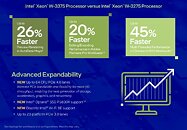
Intel Core Ultra 275HX Outshines Core i9-14900HX by 33% in Early Passmark Appearance
A recent Cinebench R23 result portrayed the upcoming Intel Core Ultra 9 275HX lagging behind its predecessor by a few points in single-core performance, despite pulling well ahead in multicore performance. Now, the high-end Arrow Lake-HX chip has made its debut on Passmark, and the result appears quite enticing, to say the least. In single-core, the Core Ultra 9 275HX leads the i9 14900HX by around 10% - a fair generational uplift. In overall performance, however, the Core Ultra 9 275HX shines bright, pulling off a 33% lead over its predecessor. Of course, the actual improvements are likely to be lower, considering that the Passmark database contains over 1800 entries for Core i9 14900HX-powered systems with varying thermal capabilities, while only a single one so far for the 275HX.
For a refresher, the Core Ultra 9 275HX debuted at CES 2025, and packs 8 Lion Cove P-cores along with 16 Skymont E-cores. Intel has left Hyper-Threading in the rearview mirror with its Arrow Lake lineup, although the Passmark entry seems to suggest Arrow Lake-HX will do just fine without it. Unsurprisingly, for laptops, the performance of the system will boil down to its thermal capabilities, which basically means that there will be a plethora of systems where the 275HX will be unable to fully spread its wings. Besides that, as with all pre-release performance benchmark leaks, be sure to accept this information with a grain of salt. The Ryzen 7945HX3D is also left behind, albeit by a far smaller margin of just around 7% in overall performance. With the Ryzen 9 9955HX3D just around the corner, however, Intel's high-end laptop reign might be short-lived after all.
For a refresher, the Core Ultra 9 275HX debuted at CES 2025, and packs 8 Lion Cove P-cores along with 16 Skymont E-cores. Intel has left Hyper-Threading in the rearview mirror with its Arrow Lake lineup, although the Passmark entry seems to suggest Arrow Lake-HX will do just fine without it. Unsurprisingly, for laptops, the performance of the system will boil down to its thermal capabilities, which basically means that there will be a plethora of systems where the 275HX will be unable to fully spread its wings. Besides that, as with all pre-release performance benchmark leaks, be sure to accept this information with a grain of salt. The Ryzen 7945HX3D is also left behind, albeit by a far smaller margin of just around 7% in overall performance. With the Ryzen 9 9955HX3D just around the corner, however, Intel's high-end laptop reign might be short-lived after all.




























